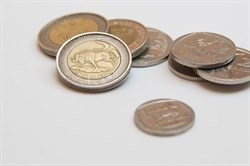With the rebound of the South African currency against the dollar in the first few weeks of March and April this year, investors are wondering what exactly to expect from the currency for the next quarter as well as for the remainder of 2014.
Mabyanine Phiri, portfolio associate at ACM Gold, says that there are several attributing factors to some of the movements of the rand, namely the FCOM monetary policy, the dollar price, gold price, as well as the general atmosphere in international markets.
"It is quite important for investors to note that the recent stabilisation and even improvement in the rand is not necessarily as a result of real growth of the economy, but rather the weakening dollar. South Africa's economy has continued to grow; however, it is slower than what was projected a year ago. In this regard, we expect growth of 2.7% this year," says Phiri.
Technical factors
"A weaker exchange rate is a risk to the inflation outlook, but supports exporters. However, sustained improvements in competitiveness require further investment in infrastructure and a range of micro-economic reforms.
"There are also a number of significant technical and fundamental factors to consider when analysing possible rand movements, such as the monetary policies of the US Federal Reserve, along with the performance of the US economy. Currently, the USD is going through the 'taper', which helps to boost the value of the USD, while all USD denominated currencies and commodities, including gold, take a toll," explains Phiri.
"This follows Bernanke's quantitative easing (QE) programme, which was initiated to give the US economy a much needed boost. However, policy makers felt that the US economy was back on track so they decided to start the tapering as of March 2014. This means that future economic data such as US employment figures and US equity market performance will be crucial in determining whether the world's biggest economy is really back on its feet."
Increase in interest rate
He says this has not necessarily been the case as we increasingly see investors turning away from the weak dollar, following fears of an end to the QE, and an increase of the interest rate prediction of as early as 2015. Adding to this is the increase in demand for investment in emerging markets such as Africa, South America and Asia, with countries like Nigeria and Zambia being top gainers in the equity exchange markets this year.
"Looking at some of ACM Gold's figures for the last quarter analysis, there has been an overwhelming increase in short position of the S&P 500 and the NASDAQ moving from 236,000 to 518,000 and 298,000 to 598,000 instrument units respectively, substantiating investor scepticism on the US economy and the dollar," says Phiri.
Gold is over-valued
Other indicators supporting this trend include increasing long positions on the German DAX, the South African JSE all share (from 320,000 to 645,000 units and 180,000 to 294,000 units respectively), the gold price and their relatively strong performance for the same period.
"We predict a correction for the US economy and dollar which should help to stabilise the gold price and subsequently the rand. Even though we believe gold has been over-valued due to its safe haven nature, we would not advise against investing in gold. In addition to its intrinsic value, gold is able to provide investors with a strong hedge against currency depreciation like in the case of the dollar," concludes Phiri.


































